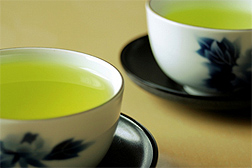This page has been archived and is being provided for reference purposes only. The page is no longer being updated, and therefore, links on the page may be invalid.
| Read the magazine story to find out more. |
|
|
|
|
Analyzing Green Tea Leaves and Supplements
By Rosalie Marion BlissApril 27, 2012
Quality control is a key factor in making sure green tea dietary supplement products pack the same antioxidant punch as green tea leaves used for brewing beverages, according to U.S. Department of Agriculture (USDA) scientists.
Green tea-based dietary supplements have gained popularity in the U.S. market in recent years. But when it comes to sipping green tea versus taking the dietary supplement form, the better choice relative to health is unknown.
Scientists with USDA's Agricultural Research Service (ARS) in Beltsville, Md., studied the differences between phytochemicals in green tea dietary supplements and green tea leaves used for brewing beverages. ARS is USDA's principal intramural scientific research agency.
Chemist Pei Chen, with the ARS Beltsville Human Nutrition Research Center, headed the study. Chen and colleagues Jianghao Sun and Long-Ze Lin analyzed extractions of 20 commercially available green tea dietary supplement products and eight dry green tea leaf samples. They compared the chemical constituents of the samples using an analytical technique called "HPLC/MS." This technique can separate one chemical constituent from another in a complex matrix. The technique also has the ability to identify and quantify chemical constituents accurately.
The study demonstrated that phytonutrients called flavonol glycosides were degraded and that another phytonutrient called catechin had oxidized during manufacturing and storage for many of the green tea supplement samples studied. They also found some additives in the supplements that were not listed on the labels.
The researchers concluded that although there are fine green tea dietary supplement products, there is no way for the consumer to know the qualities of those products from reading the labels. In addition, the consumer may ingest other botanical extracts unintentionally, and the quality of those green tea products varies significantly. The 2011 study was published in the Journal of AOAC International.
Read more about this research in the April 2012 issue of Agricultural Research magazine.

